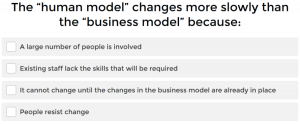A propensity model is a statistical analysis of your target audience that predicts their future actions, using a range of datasets that typically includes demographics, psychographics (eg: interests) and previous behaviour. For example, you could create a propensity model for existing customers using their personal data, purchase history and actions between each purchase to predict their future purchase decisions.
How do marketers use propensity models?
Propensity models are used to predict the future actions of specific audiences. If we take the example above of a model that predicts the purchase decisions of existing customers, there are several ways you can use the outcomes of this model to enhance sales and marketing campaigns:
- Increase the frequency of purchases
- Increase the value of purchases
- Attribute purchases to campaigns/interactions
- Identify drops in purchase rate
- Identify churn dangers
- Calculate customer lifetime value
- Prioritise high-value customers
For example, your model might determine that the average customer makes a purchase every 227 days. From this, you can calculate that increasing purchase frequency to >200 days will lift annual revenue by 13+%.
Now, you have a clear goal to inform campaign ideas designed to increase purchase incentive in the build-up to your 200-day target, increase the percentage of repeat buyers and other objectives that will reduce the average time between purchases.
Propensity modelling predicts the future actions of your target audiences and identifies the triggers that inspire them. This allows you to influence decisions before they’re even made. Instead of responding to historical actions, you’re reacting to signals that suggest people are about to make a choice and get your message across while they’re still open to influence.
So you’re not trying to change someone’s mind; you’re helping them make it at the key moment.
How to start with propensity modelling
Propensity modelling relies on large volumes of relevant data to make accurate predictions. This starts with accurately attributing historical actions to campaigns and interactions across the consumer journey, so that you can build a library of signals related to each specific action – eg: the frequency of product page views before a purchase is made or the number of checkout attempts before cart abandonment.
The more comprehensive your datasets are, the more granular your propensity models and predictions will be – provided your attribution is accurate.
The golden rule with any machine learning application is that the output is only ever as good as the data you feed into it. With 57% of marketers feeling overwhelmed by data, many fall at this first key hurdle and never realise the full potential of strategies like propensity modelling.
Business & Finance Articles on Business 2 Community
(41)




